2017 Hyundai Elantra instrument panel
[x] Cancel search: instrument panelPage 12 of 571
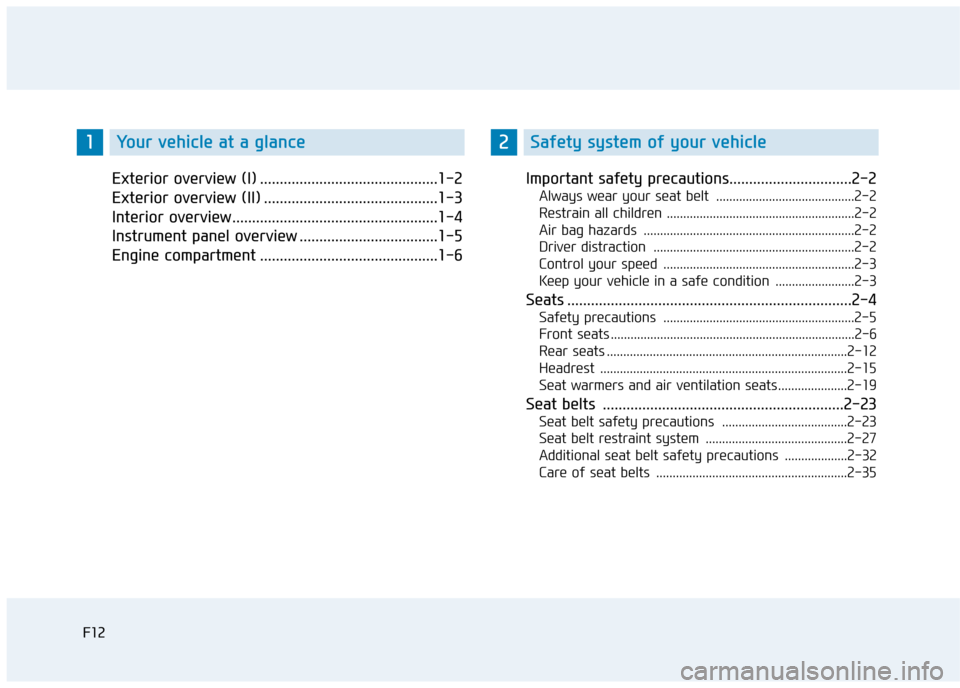
F12F12
Exterior overview (I) .............................................1-2
Exterior overview (II) ............................................1-3
Interior overview ....................................................1-4
Instrument panel overview ...................................1-5
Engine compartment .............................................1-6
Important safety precautions...............................2-2
Always wear your seat belt ..........................................2-2
Restrain all children .........................................................2-2
Air bag hazards ................................................................2-2
Driver distraction .............................................................2-2
Control your speed ..........................................................2-3
Keep your vehicle in a safe condition ........................2-3
Seats ........................................................................2-4
Safety precautions ..........................................................2-5
Front seats ..........................................................................2-6
Rear seats .........................................................................2-12
Headrest ...........................................................................2-15
Seat warmers and air ventilation seats.....................2-19
Seat belts .............................................................2-23
Seat belt safety precautions ......................................2-23
Seat belt restraint system ...........................................2-27
Additional seat belt safety precautions ...................2-32
Care of seat belts ..........................................................2-35
1Yo u r v e h i c l e a t a g l a n c e2Safety system of your vehicle
Page 22 of 571
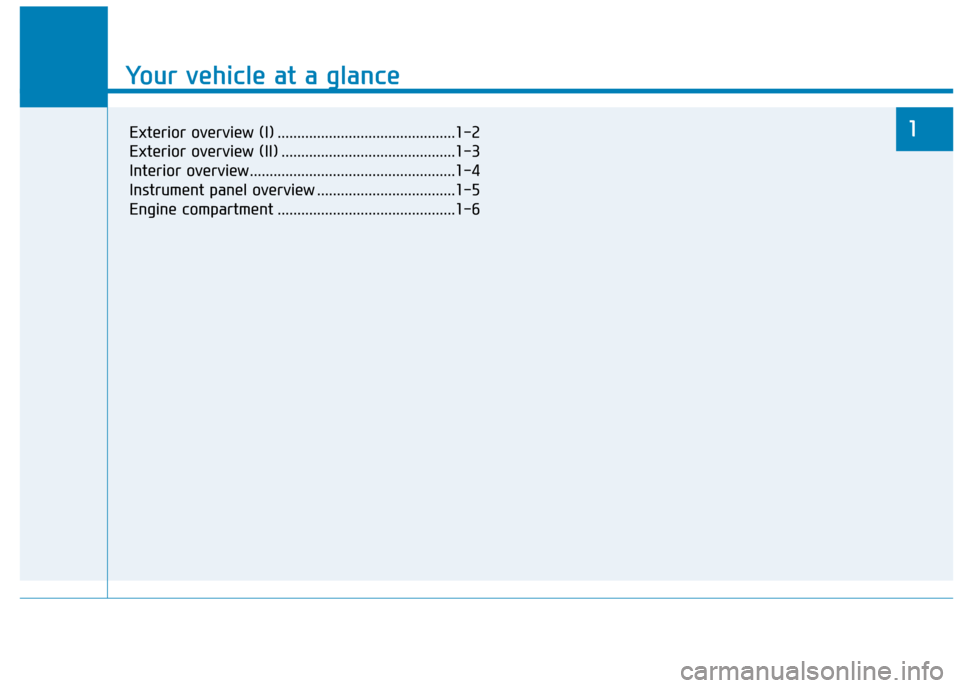
Yo u r v e h i c l e a t a g l a n c e
1
Yo u r v e h i c l e a t a g l a n c e
1Exterior overview (I) .............................................1-2
Exterior overview (II) ............................................1-3
Interior overview ....................................................1-4
Instrument panel overview ...................................1-5
Engine compartment .............................................1-6
Page 25 of 571
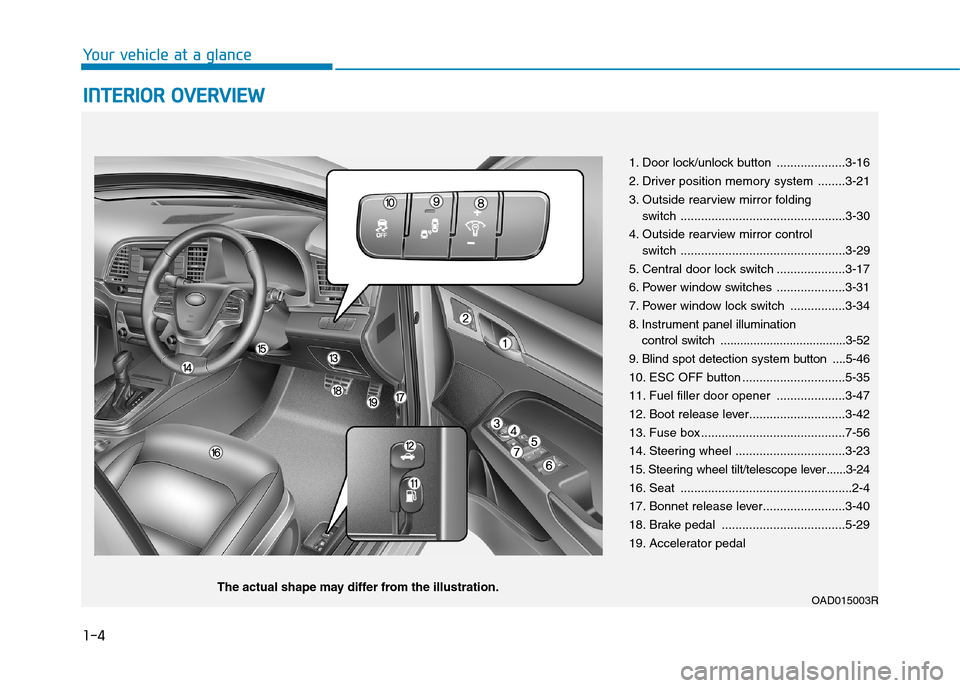
1-4
Yo u r v e h i c l e a t a g l a n c e
IINNTTEERRIIOORR OOVVEERRVVIIEEWW
1. Door lock/unlock button ....................3-16
2. Driver position memory system ........3-21
3. Outside rearview mirror folding
switch ................................................3-30
4. Outside rearview mirror control
switch ................................................3-29
5. Central door lock switch ....................3-17
6. Power window switches ....................3-31
7. Power window lock switch ................3-34
8. Instrument panel illumination
control switch ......................................3-52
9. Blind spot detection system button ....5-46
10. ESC OFF button ..............................5-35
11. Fuel filler door opener ....................3-47
12. Boot release lever............................3-42
13. Fuse box ..........................................7-56
14. Steering wheel ................................3-23
15. Steering wheel tilt/telescope lever ......3-24
16. Seat ..................................................2-4
17. Bonnet release lever........................3-40
18. Brake pedal ....................................5-29
19. Accelerator pedal
OAD015003RThe actual shape may differ from the illustration.
Page 32 of 571
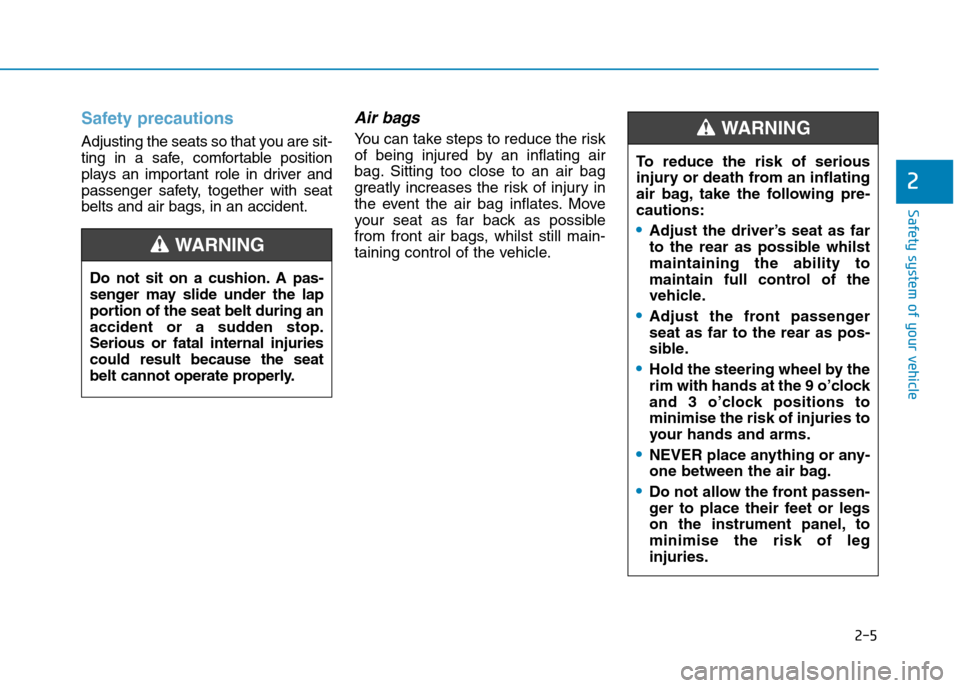
2-5
Safety system of your vehicle
2
Safety precautions
Adjusting the seats so that you are sit-
ting in a safe, comfortable position
plays an important role in driver and
passenger safety, together with seat
belts and air bags, in an accident.
Air bags
Yo u c a n t a k e s t e p s t o r e d u c e t h e r i s k
of being injured by an inflating air
bag. Sitting too close to an air bag
greatly increases the risk of injury in
the event the air bag inflates. Move
your seat as far back as possible
from front air bags, whilst still main-
taining control of the vehicle.
Do not sit on a cushion. A pas-
senger may slide under the lap
portion of the seat belt during an
accident or a sudden stop.
Serious or fatal internal injuries
could result because the seat
belt cannot operate properly.
WA R N I N G
To r e d u c e t h e r i s k o f s e r i o u s
injury or death from an inflating
air bag, take the following pre-
cautions:
•Adjust the driver’s seat as far
to the rear as possible whilst
maintaining the ability to
maintain full control of the
vehicle.
•Adjust the front passenger
seat as far to the rear as pos-
sible.
•Hold the steering wheel by the
rim with hands at the 9 o’clock
and 3 o’clock positions to
minimise the risk of injuries to
your hands and arms.
•NEVER place anything or any-
one between the air bag.
•Do not allow the front passen-
ger to place their feet or legs
on the instrument panel, to
minimise the risk of leg
injuries.
WA R N I N G
Page 33 of 571
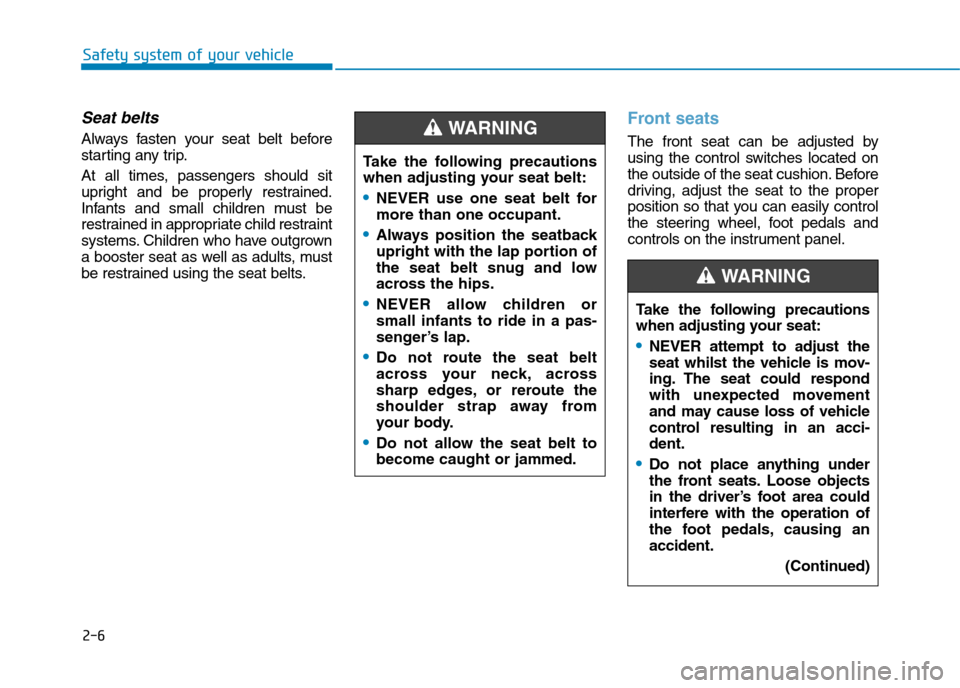
2-6
Safety system of your vehicle
Seat belts
Always fasten your seat belt before
starting any trip.
At all times, passengers should sit
upright and be properly restrained.
Infants and small children must be
restrained in appropriate child restraint
systems. Children who have outgrown
a booster seat as well as adults, must
be restrained using the seat belts.
Front seats
The front seat can be adjusted by
using the control switches located on
the outside of the seat cushion. Before
driving, adjust the seat to the proper
position so that you can easily control
the steering wheel, foot pedals and
controls on the instrument panel.
Ta k e t h e f o l l o w i n g p r e c a u t i o n s
when adjusting your seat belt:
•NEVER use one seat belt for
more than one occupant.
•Always position the seatback
upright with the lap portion of
the seat belt snug and low
across the hips.
•NEVER allow children or
small infants to ride in a pas-
senger’s lap.
•Do not route the seat belt
across your neck, across
sharp edges, or reroute the
shoulder strap away from
your body.
•Do not allow the seat belt to
become caught or jammed.
WA R N I N G
Ta k e t h e f o l l o w i n g p r e c a u t i o n s
when adjusting your seat:
•NEVER attempt to adjust the
seat whilst the vehicle is mov-
ing. The seat could respond
with unexpected movement
and may cause loss of vehicle
control resulting in an acci-
dent.
•Do not place anything under
the front seats. Loose objects
in the driver’s foot area could
interfere with the operation of
the foot pedals, causing an
accident.
(Continued)
WA R N I N G
Page 36 of 571
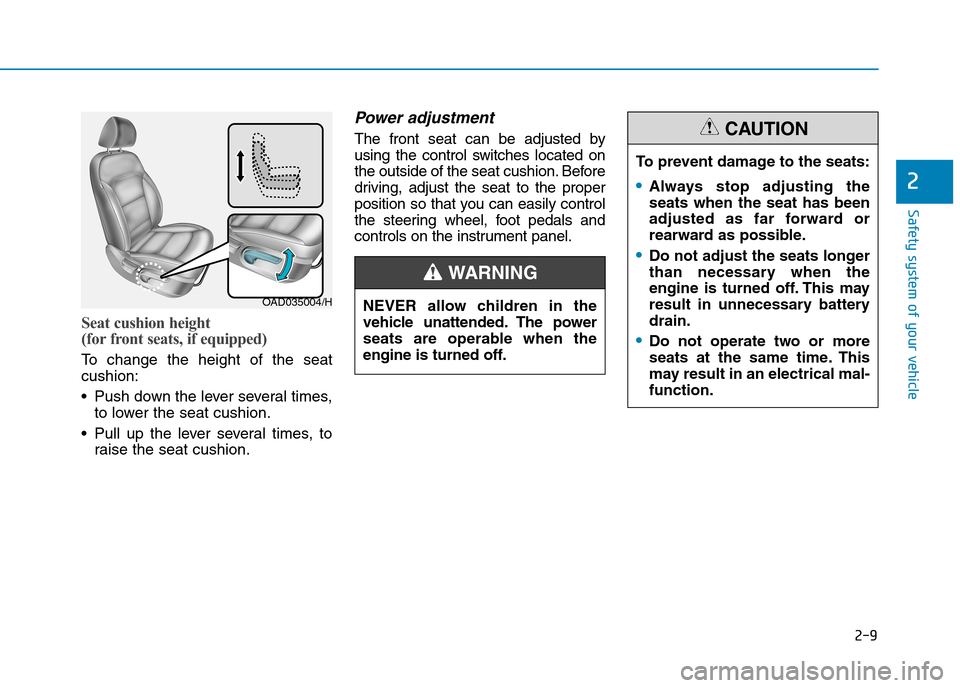
2-9
Safety system of your vehicle
Seat cushion height
(for front seats, if equipped)
To c h a n g e t h e h e i g h t o f t h e s e a t
cushion:
•Push down the lever several times,
to lower the seat cushion.
•Pull up the lever several times, to
raise the seat cushion.
Power adjustment
The front seat can be adjusted by
using the control switches located on
the outside of the seat cushion. Before
driving, adjust the seat to the proper
position so that you can easily control
the steering wheel, foot pedals and
controls on the instrument panel.
2
OAD035004/H
To p r e v e n t d a m a g e t o t h e s e a t s :
•Always stop adjusting the
seats when the seat has been
adjusted as far forward or
rearward as possible.
•Do not adjust the seats longer
than necessary when the
engine is turned off. This may
result in unnecessary battery
drain.
•Do not operate two or more
seats at the same time. This
may result in an electrical mal-
function.
CAUTION
NEVER allow children in the
vehicle unattended. The power
seats are operable when the
engine is turned off.
WA R N I N G
Page 76 of 571
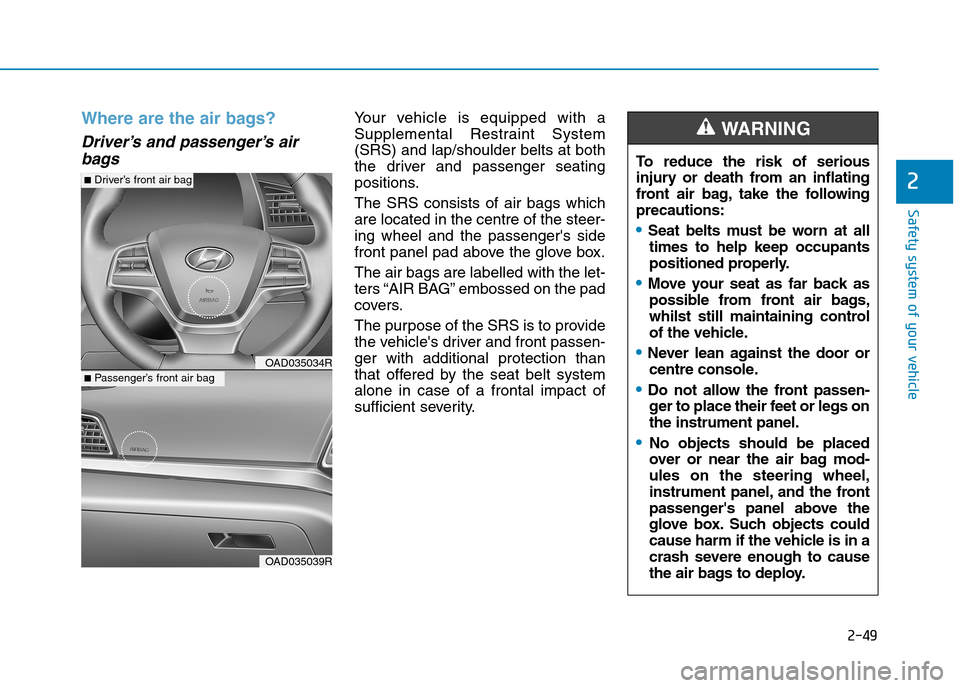
2-49
Safety system of your vehicle
2
Where are the air bags?
Driver’s and passenger’s air
bags
Yo u r v e h i c l e i s e q u i p p e d w i t h a
Supplemental Restraint System
(SRS) and lap/shoulder belts at both
the driver and passenger seating
positions.
The SRS consists of air bags which
are located in the centre of the steer-
ing wheel and the passenger's side
front panel pad above the glove box.
The air bags are labelled with the let-
ters “AIR BAG” embossed on the pad
covers.
The purpose of the SRS is to provide
the vehicle's driver and front passen-
ger with additional protection than
that offered by the seat belt system
alone in case of a frontal impact of
sufficient severity.
OAD035034R
OAD035039R
■Driver’s front air bag
■Passenger’s front air bag
To r e d u c e t h e r i s k o f s e r i o u s
injury or death from an inflating
front air bag, take the following
precautions:
•Seat belts must be worn at all
times to help keep occupants
positioned properly.
•Move your seat as far back as
possible from front air bags,
whilst still maintaining control
of the vehicle.
•Never lean against the door or
centre console.
•Do not allow the front passen-
ger to place their feet or legs on
the instrument panel.
•No objects should be placed
over or near the air bag mod-
ules on the steering wheel,
instrument panel, and the front
passenger's panel above the
glove box. Such objects could
cause harm if the vehicle is in a
crash severe enough to cause
the air bags to deploy.
WA R N I N G
Page 80 of 571

2-53
Safety system of your vehicle
2
SRS warning light
The SRS air bag warning light on the
instrument panel will illuminate for
about 6 seconds after the ignition
switch is tur ned to the ON position,
after which the air bag warning light
should go out.
During a frontal collision, sensors will
detect the vehicle’s deceleration. If
the rate of deceleration is high
enough, the control unit will inflate
the front air bags, at the time and
with the force needed.
The front air bags help protect the
driver and front passenger by
responding to frontal impacts in
which seat belts alone cannot pro-
vide adequate restraint. When need-
ed, the side air bags help provide
protection in the event of a side
impact.
•Air bags are activated (able to
inflate if necessary) only when the
ignition switch is in the ON posi-
tion.
•Air bags inflate in the event of cer-
tain frontal or side collisions to help
protect the occupants from serious
physical injury.
•Generally, air bags are designed to
inflate based upon the severity of a
collision it’s direction etc. These
two factors determine whether the
sensors produce an electronic
deployment/inflation signal.
If your SRS malfunctions, the
air bag may not inflate properly
during an accident increasing
the risk of serious injury or
death.
If any of the following condi-
tions occur, your SRS is mal-
functioning:
•The light does not turn on for
approximately six seconds
when the ignition switch is in
the ON position.
•The light stays on after illumi-
nating for approximately six
seconds.
•The light comes on whilst the
vehicle is in motion.
•The light blinks when the
engine is running.
We recommend that an autho-
rised HYUNDAI dealer inspect
the SRS as soon as possible if
any of these conditions occur.
WA R N I N G